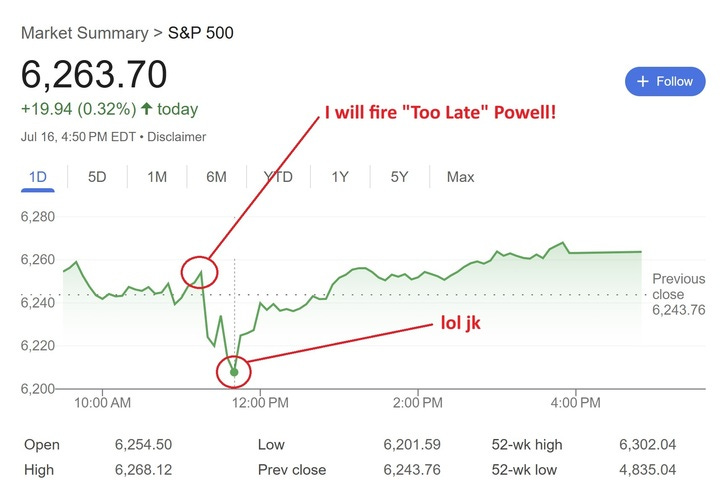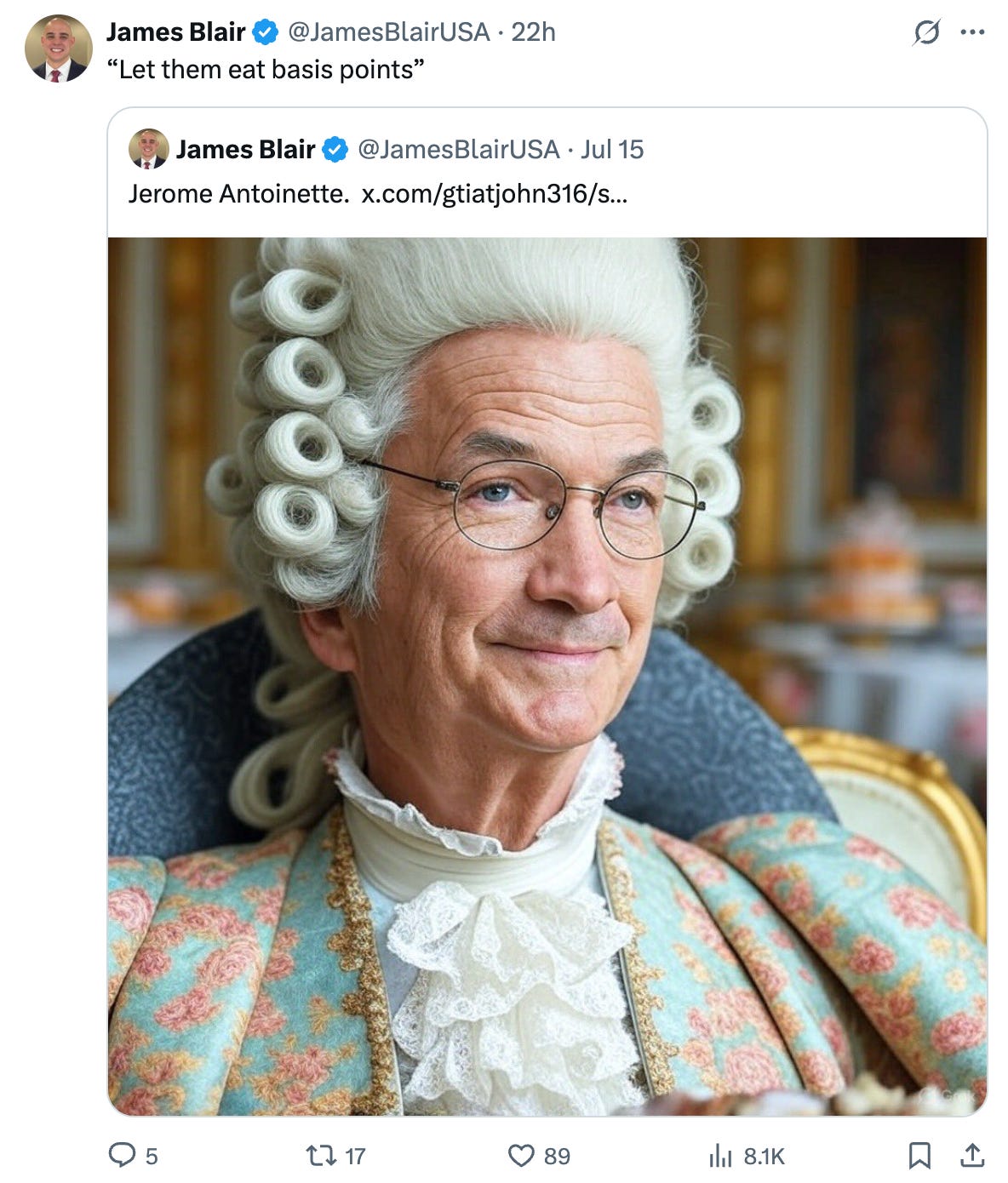Can Trump Actually Fire Fed Chair Jerome Powell?
It's ... complicated.
On Wednesday, the stock market briefly dropped on news that President Trump was about to fire Federal Reserve Chairman Jerome Powell.
In the morning, Bloomberg reported that Powell’s ouster was imminent. The New York Times followed up with a story claiming that a couple dozen Republican members of Congress showed up in the Oval Office Tuesday night for a meeting about crypto, only to be confronted by a strange, orange man waving around a UR FIRED letter and demanding to know who was in favor of giving Powell the boot.
“Jerome Powell is going to be fired. Firing is imminent,” tweeted Florida Rep. Anna Paulina Luna, seemingly confirming the story. Although Luna has been known to tell a whopper or two in her day, so YMMV.
Trump, who has also been known to tell a whopper or two, affected astonishment that Biden would have appointed Powell. In fact Trump himself first installed Powell in 2018.
Then in the afternoon, Trump backtracked, saying that Powell’s removal was “highly unlikely unless he has to leave for fraud.”
So, WTF is going on?
Who fed who what now?
The Federal Reserve is America’s central bank, tasked with managing the nation’s monetary policy. It has twelve Regional Reserve Banks and a Board of Governors based in DC. The board is made up of seven members nominated by the president and approved by the Senate to staggered, 14-year terms. Powell is currently chair of this board after first being nominated by Trump in 2018 and then renominated by Biden in 2022.
The Federal Open Market Committee (FOMC) is composed of the seven governors plus a rotating roster of five regional bank heads. It meets at least eight times a year to discuss the health of the economy and set the federal funds rate, which is the interest rate banks charge to lend each other money held at the Fed. Because so much lending in America is pegged to the federal rate, it functions as a key mechanism for the reserve bankers to push the accelerator or the brakes on the economy.
Lower interest rates make it cheaper to borrow, so Americans feel richer and spend more freely, while higher interest rates do the opposite. Presidents always favor lower rates, because their own approval ratings are tied to voters’ subjective feelings about the economy. But when inflation is rising, the Fed raises interest rates to “take away the punch bowl” and cool things off. That’s why it’s critical for the Federal Reserve to remain independent of politics, because it has to be free to do politically unpopular things to ensure the health and stability of the economy.
It’s also the reason Trump hates Jerome Powell.
Jonesing for a fix
Fed chairs are almost always renominated for a second term, since stable governance makes markets happy. But in 2018 Trump decided Janet Yellen was too short to understand monetary policy, so he promoted Powell to the job instead. Powell, a veteran of George H. W. Bush’s Treasury who was named to the Board of Governors by Obama, favored the same disciplined, moderate strategy as his predecessor.
Almost immediately, Trump soured on his pick, and throughout his first term he made impotent noises about firing Powell. But at that time, no one thought the Supreme Court would be crazy enough to let him do it. (We were so young….)
During the 2024 election, Trump’s advisors came up with a plan to blunt the power of the Fed by firing Powell and installing someone in his place who would consult with Trump on interest rate changes. Subordinating the Fed to the White House would be catastrophic: The Fed only “works” because markets believe that it will do the “right” thing, not the thing that is politically expedient in the short term for the sitting president. And so the campaign rushed to refute the story when the Wall Street Journal reported it.
But since his inauguration, Trump has lobbed a steady barrage of abuse against the chair, whom he has nicknamed “Too Late.”
“Fed should cut Rates by 3 Points. Very Low Inflation. One Trillion Dollars a year would be saved!!!” he screeched on July 15.
In fact inflation is rising, thanks to Trump’s harebrained tariffs. But Trump still demands that Powell bend to his bidding and hit the gas on the economy, while insisting that he can unilaterally remove him at any time.
But can he do that?
Well, no. But!
Under 12 USC § 242, “each member [of the Board of Governors] shall hold office for a term of fourteen years from the expiration of the term of his predecessor, unless sooner removed for cause by the President.”
That would appear to constrain the power of the president to fire Powell at will, since Congress specified that governors can only be removed for cause. Except there are a whole lot of statutes with language protecting agency heads and board members, and the Supreme Court just let Trump fire them all anyway. That includes members of the National Labor Relations Board, who by statute “may be removed by the President, upon notice and hearing, for neglect of duty or malfeasance in office, but for no other cause” and the Merit Systems Protection Board, who “may be removed by the President only for inefficiency, neglect of duty, or malfeasance in office.”
And still, the Court’s conservatives ruled on May 22 that “the Government is likely to show that both the NLRB and MSPB exercise considerable executive power” and “the Government faces greater risk of harm from an order allowing a removed officer to continue exercising the executive power than a wrongfully removed officer faces from being unable to perform her statutory duty.”
This would strongly suggest that Trump has the power to fire anyone in the executive branch at any time and for any reason. And indeed a coalition of law professors filed an amicus brief in that case warning that allowing Trump to fire MSPB and NLRB members would necessarily mean he could fire Powell, too.
“Staying the District Court’s judgment in this matter could shake belief in the Fed’s capacity to act independently in formulating monetary policy and addressing financial instability,” they warned, adding that “the Court cannot easily avoid these consequences by simply announcing a ‘Fed exception.’”
Which is exactly what the Supreme Court did.
“The Federal Reserve is a uniquely structured, quasi-private entity that follows in the distinct historical tradition of the First and Second Banks of the United States,” the conservatives wrote, gesturing vaguely in the direction of Seila Law, the 2020 case in which Chief Justice Roberts invented a heretofore unknown distinction between single- and multi-member boards, suggesting for the first time that Congress only has the power to shield the latter from untoward political interference. (As Justice Kagan pointed out in her dissent, this logic is exactly backwards, noting that “Congress constructed the Federal Reserve as it did” because it is “easier to protect a board from political control than to protect a single appointed official.”)
The MSPB and NLRB, like the Fed, are also multi-member boards. But when you’re making up new rules on the fly as an excuse to give a wannabe dictator what he demands, you can’t let yourself get bogged down in the details.
Will no one rid me of this turbulent priest?
It’s unclear whether Trump will be dissuaded from firing Powell by a sentence of dicta in a three-paragraph shadow docket order. But he appears to be making alternate plans to rid himself of Powell anyway.
Plan B involves accusing Powell of “fraud” in conjunction with an ongoing renovation of the Federal Reserve Bank’s facilities, which is estimated to cost $2.5 billion and run $700 million over budget. This week Trump’s allies launched a smear campaign against Powell as an obvious pretext to claim Trump has “cause” to fire him.
Russ Vought, the head of the Office of Management and Budget, went on CNBC to call out Powell for “fundamental mismanagement” and tweeted out a nasty letter in which he accused the chair of “plowing ahead with an ostentatious overhaul” instead of “attempting to right the Fed’s fiscal ship.”
William Pulte, the director of the Federal Housing Finance Agency, claims that the project is “riddled with Fraud and likely explains the gross negligence that Jerome Powell has exhibited in his ‘hallucinations’ that tarriffs [sic] cause inflation (they don’t).”
And White House Deputy Chief of Staff James Blair is calling him “Jerome Antoinette.”
Suddenly the entire Trump administration is posting multiple times a day that Powell is a fraudster. It’s not subtle.
“It’s possible there’s fraud involved with the $2.5, $2.7 billion renovation. This is a renovation — how do you spend $2.7 billion?” Trump said Wednesday, adding “There could be something to that, but I think he’s not doing a good job. He’s got a very easy job to do. You know what he has to do? Lower interest rates.”
So … now what?
So far, the stock market seems to be betting on the TACO principle. Everyone assumes that Trump will chicken out and put up with Powell for another ten months until his term expires in May, and then try to get someone more pliant in there. After all, the steady hand of the Fed dampens the market reaction to Trump’s erratic behavior with respect to tariffs and government contracts.
At the same time, it’s impossible to ignore the all-out effort to slime Powell amid rumors that Trump’s buffoonish economic advisor Kevin Hassett is in line to replace him.
In 2021, Hassett wrote that firing Powell would have “savaged the reputation” of the Fed, weakened the dollar, and potentially crashed the stock market. Today …
This is not good.







In a large factory, in a small village in Central China, workers are cutting cheap cloth to make the swastika arm-bands and banners that will be featured at the January 2029 Coronation of King Trump the First.